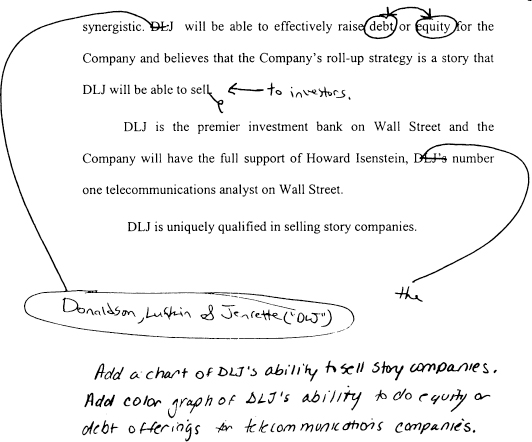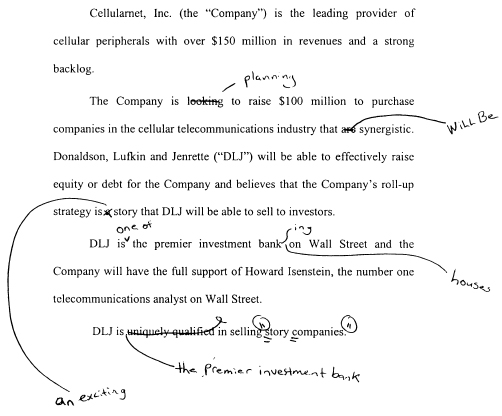Monkey Business (16 page)
Authors: John Rolfe,Peter Troob

The next day the draft clawed its way up one level in the hierarchy to the senior vice president. The senior vice president
took a look at the executive summary and made his changes as such:


The senior vice president I was working for loved graphs and charts. He had already mastered the art of written bullshit in
the pitch books and was pursuing a loftier goal of impressing companies with color graphs and charts. It was truly amazing.
I got the marked-up document back around 6:00
P.M
. and the word processing marathon began again. I put the changes through word processing and when I was done the vice president
wanted to see the finished product to make sure that it was OK to send to the senior vice president. This checking and double
checking is a staple of investment banking. I then faxed the document to the senior vice president at his house. He made all
these changes to the other changes and faxed them back to me. I sent it through word processing and proofed it. It
inevitably wasn’t right, so I had to send it through word processing again. Then the vice president wanted it faxed back to
his apartment, and he made even more changes. By this time it was midnight and the ridiculousness seemed like it would never
end.
The next day the managing director looked at the executive summary and changed it again. His edits looked like this:


This managing director loved presentation. Colors had to be right, fonts easy to read, bolding clear, and underlining thick.
I sent these changes through word processing, showed it to the senior vice president who touched it up a bit, sent it through
word processing again, showed it to the vice president, who changed a couple of nits like commas and fonts, and sent it through
word processing yet again. Then I faxed the document to the home of the managing director. It was about 6:00
P.M
. He made some changes and faxed the document back to me. I sent it through word processing and faxed it to the senior vice
president. He put his stamp of acceptance on it and then I sent it to the vice president and he also stamped it OK. Changes
had gone back and forth and forty-eight hours of my life were consumed, and the document hadn’t changed substantially from
its original form except for the addition of a couple of graphs and charts.
Cellularnet, Inc. (the “Company”) is the leading provider of cellular peripherals with over $150 million in revenues and a
strong backlog.
The Company is planning to raise $100 million to purchase
companies in the cellular telecommunications industry that will be synergistic. Donaldson, Lufkin and Jenrette (“DLJ”) will
be able to effectively raise equity or debt for the Company and believes that the Company’s roll-up strategy is an exciting
story that DLJ will be able to sell to investors.
DLJ is one of the premier investment banking houses on Wall Street and the Company will have the full support of Howard Isenstein,
the number one telecommunications analyst on Wall Street.
DLJ is the premier investment bank in selling “Story Companies.”

So, when is the word processing of a document really done? The answer is twelve hours before the time of the meeting with
the company. If a pitch to a company was in a week, then the vice president, senior vice president, and managing director
would come up with more charts, graphs, and drivel to put into the pitch until there were just twelve hours till showtime.
When it’s just twelve hours till showtime the associate has to put the pitch books into production.
Next stop: copy center.
The trouble with being punctual is that there’s nobody there to appreciate it
.
—
Harold Rome
T
his is a chapter about the copy center. It’s not about big, fat investment banking salaries. It’s not about stocks or bonds.
It’s not about leveraged buyouts or parties where overpaid old men look for love from their secretaries. It’s about the copy
center. It’s not intuitive, but it’s what matters. Before Troob and I ever became bankers, if somebody had asked us what the
most important areas in the investment bank were we would have said “the trading floor” or “the institutional sales department.”
Maybe we would have said “the golf course.” Under no circumstances, though, would we ever have said “the copy center.” It
wouldn’t have made sense. We were bankers. We did deals. We didn’t make copies.
We learned quickly.
Our success, or lack thereof, in banking would be dependent on a long row of Xerox copiers operated by a platoon of patriotic
Puerto Ricans. They were the revolutionaries,
capable of being either our greatest allies or our most heinous enemies. To get on their bad side was to commit hari-kari.
A banker with no copy-making abilities is impotent, so the militants in the copy center became our best friends. There were
times when we would have given a round of blowjobs to the entire copy center staff if they’d requested it. We would have done
it with a big smile on our faces, and we would have swallowed. Anything for the copy center guys.
The word processing department is the brains of the operation. The brains are no good, though, without a pair of hands. A
genius can think up brilliant ideas all day, but if he can’t make them happen, then the ideas aren’t any better than a clock
with no key to wind it up. The copy center is that key. The copy center takes the ideas put on paper by the word processing
department and makes copies of these ideas. The copy center disseminates the ideas so as to make them come alive. The copy
center is the pair of hands that turns the brain’s ideas into something real. It’s where the ideas become actual, tangible
things—big fat stacks of paper and pitch books that say “Donaldson, Lufkin & Jenrette” on the spine.
Some investment bankers measure their success by the amount of paper that they generate. They’re known as the Paper Bankers.
For the Paper Bankers, more is better. Paper Bankers make copies of financial statements, models, and research reports and
pass them out to everybody, even people who aren’t connected with their deal. That helps them cover their ass, and keeps people
from screaming, “Why the fuck didn’t you tell me about this!” later on. Sometimes the Paper Bankers don’t even need
a reason to make copies. They’ll just send a stack of miscellaneous stuff to the copy center and get fifty copies made because
they haven’t gotten many copies done lately. It soothes their savage beast within.
At DLJ, the copy center wasn’t actually run by DLJ employees. It was inside of DLJ, though, and anybody who wasn’t paying
attention probably thought that it was actually a part of DLJ, but it wasn’t. The copy center function was outsourced to a
service company that ran copy centers at a bunch of big companies in New York. Many bankers are rude to anybody who they think
is making less money than them, and that includes all of the service people who help them get their jobs done. A lot of the
DLJ bankers, though, figured that they could be
extra
rude to the copy center people since they weren’t actually company employees. It was like they thought that they could be
as rude as they wanted to, and if the copy center people lodged complaints, then the banker would threaten their big boss—“Those
goddamned copy center employees of yours, if they don’t get a better fucking attitude we’ll take the service contract away.”
The good bankers didn’t usually make that mistake more than once.
The copy center is where the bottlenecks always pop up in the pitch book–making process. Bottlenecks occur in word processing,
but not to the magnitude of copy center bottlenecks. In word processing the fonts inevitably get screwed up or underlines
are botched. Although annoying and time-consuming, all of these problems are easily fixed. Also, during the word processing
stage the associate feels time pressure, but nothing like what the associate feels during the copy center stage.
By the time the copy center stage is reached, the associate knows that the pitch is going to occur the next morning. We believe
that we’re accurate when we say that never in the history of investment banking has a pitch book been sent to the copy center
twenty-four hours in advance. If a banker has the time to dicker around with a document, then he will. So a banker will never
allow a pitch book to be complete before it absolutely, positively has to be complete. And that is exactly twelve hours before
the presentation of the pitch book to the prospective client.
Like clockwork, a junior banker with the most important pitch of his life will walk into the copy center at 2
A.M
. with a pitch book ready and tell the guy behind the counter, “I need twenty copies by seven
A.M
.” and the copy center guy behind the counter will say, “Join the crowd, my brother. Join the crowd.” The copy center guy
will then point to a huge stack of other pitch books that have to be made by 7
A.M
. and tell the banker, “You’ll be lucky if we get it done by noon tomorrow. Sorry.”